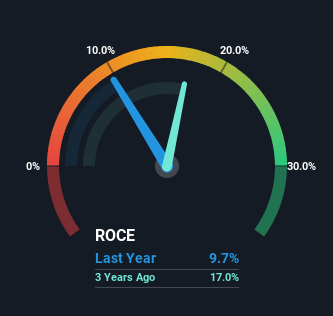Stock Analysis
- Netherlands
- /
- Chemicals
- /
- ENXTAM:CRBN
Returns On Capital Signal Tricky Times Ahead For Corbion (AMS:CRBN)

If we want to find a potential multi-bagger, often there are underlying trends that can provide clues. Ideally, a business will show two trends; firstly a growing return on capital employed (ROCE) and secondly, an increasing amount of capital employed. If you see this, it typically means it's a company with a great business model and plenty of profitable reinvestment opportunities. Although, when we looked at Corbion (AMS:CRBN), it didn't seem to tick all of these boxes.
What Is Return On Capital Employed (ROCE)?
For those that aren't sure what ROCE is, it measures the amount of pre-tax profits a company can generate from the capital employed in its business. To calculate this metric for Corbion, this is the formula:
Return on Capital Employed = Earnings Before Interest and Tax (EBIT) ÷ (Total Assets - Current Liabilities)
0.097 = €108m ÷ (€1.7b - €593m) (Based on the trailing twelve months to December 2022).
Thus, Corbion has an ROCE of 9.7%. Even though it's in line with the industry average of 9.7%, it's still a low return by itself.
View our latest analysis for Corbion

Above you can see how the current ROCE for Corbion compares to its prior returns on capital, but there's only so much you can tell from the past. If you're interested, you can view the analysts predictions in our free report on analyst forecasts for the company.
What Does the ROCE Trend For Corbion Tell Us?
When we looked at the ROCE trend at Corbion, we didn't gain much confidence. Around five years ago the returns on capital were 19%, but since then they've fallen to 9.7%. However, given capital employed and revenue have both increased it appears that the business is currently pursuing growth, at the consequence of short term returns. If these investments prove successful, this can bode very well for long term stock performance.
While on the subject, we noticed that the ratio of current liabilities to total assets has risen to 35%, which has impacted the ROCE. Without this increase, it's likely that ROCE would be even lower than 9.7%. Keep an eye on this ratio, because the business could encounter some new risks if this metric gets too high.
The Bottom Line
In summary, despite lower returns in the short term, we're encouraged to see that Corbion is reinvesting for growth and has higher sales as a result. However, despite the promising trends, the stock has fallen 17% over the last five years, so there might be an opportunity here for astute investors. So we think it'd be worthwhile to look further into this stock given the trends look encouraging.
If you'd like to know more about Corbion, we've spotted 3 warning signs, and 2 of them make us uncomfortable.
If you want to search for solid companies with great earnings, check out this free list of companies with good balance sheets and impressive returns on equity.
Valuation is complex, but we're helping make it simple.
Find out whether Corbion is potentially over or undervalued by checking out our comprehensive analysis, which includes fair value estimates, risks and warnings, dividends, insider transactions and financial health.
View the Free AnalysisHave feedback on this article? Concerned about the content? Get in touch with us directly. Alternatively, email editorial-team (at) simplywallst.com.
This article by Simply Wall St is general in nature. We provide commentary based on historical data and analyst forecasts only using an unbiased methodology and our articles are not intended to be financial advice. It does not constitute a recommendation to buy or sell any stock, and does not take account of your objectives, or your financial situation. We aim to bring you long-term focused analysis driven by fundamental data. Note that our analysis may not factor in the latest price-sensitive company announcements or qualitative material. Simply Wall St has no position in any stocks mentioned.
About ENXTAM:CRBN
Corbion
Corbion N.V. provides lactic acid and lactic acid derivatives, other ferment, functional enzyme blends, minerals, vitamins, and algae ingredients worldwide.
Mediocre balance sheet second-rate dividend payer.

